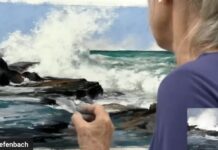
We just started a series of painting demonstrations by the master artists who will be sharing their ideas and inspiration during the Plein Air Convention & Expo, in Monterey, California from April 10-14, 2013 (www.pleinairconvention.com). This week we asked Guido Frick what he believes are the most important aspects of painting.
“Painting is a matter of emotions, not intellect,” says Guido Frick. “It’s not about telling stories or being a great draftsman, and it is not about painting what’s in a photograph. It’s OK to use a photograph as a drawing reference, but never for checking color, value, or temperatures. I’m also opposed to painting with a palette knife because, in my opinion, a palette knife is a tool to take paint off of a palette or canvas, but not for applying color to a painting. Many folks use a knife to hide their inability to handle a brush effectively.”

A recent landscape painting by Guido Frick
Frick is a German-born painter who lives half the year in Europe and travels the other half through America’s western states. After studying art in Prague, Czechoslovakia, in the 1970s, Frick met the famous art instructor Sergei Bongart (1918-1985), and he still considers that encounter to be his most influential experience. He says, “Sergei truly opened my eyes and showed me the way.”
In describing the approach to plein air painting he will present during the Plein Air Convention & Expo, Frick says he tries to teach people how to see, not how to paint. “Unless artists can actually see the right color, the correct relative value, and the appropriate color temperature, they will be like a blind farmer who sometimes accidentally finds a big potato,” he says with a laugh. “When artists know how to judge color, temperature, and value, they will know how to mix colors on their palette. In my workshops and during my demonstrations during the Plein Air Convention & Expo, I help people find the right color purposely and not accidentally.
“In addition to grasping those fundamentals, it’s important to analyze a potential subject before picking up a brush full of paint. That analysis becomes a road map through the painting. If that road map is carefully plotted, a painter can surrender to instinct and allow their emotions to guide their brush. The goal is not to paint from a formula, but rather to paint passages instead of objects. Amateurs paint objects while professionals paint passages. And as for the question of style, being concerned about style leads to wrong thinking. Style develops over years just like handwriting.”

One of Frick’s still life paintings
Frick goes on, “I paint with about a dozen colors, plus ivory black and titanium white. My color layout has been the same for 30 years, and it includes warm and cool blues, warm and blue yellows, warm and blue reds, plus a green, and two earth colors. That’s it. I don’t care for particular brands as long as the oil colors are professional-grade.
“As for the rest of the supplies I recommend that students bring to a workshop, I ask them to have some canvases in sizes 20” x 24” and 24” x 30” — linen or cotton. For small sketches, I recommend painting on Masonite in size 5” x 7”, 8” x 10”, 9” x 11”, and 11” x 14”.”

Another recent landscape painting
Frick adds emphatically, “I am strictly an outdoor painter. Eugene Boudin, Claude Monet’s first teacher, once said: ‘Five brushstrokes in plein air are worth more than two days’ worth of brushstrokes made in the studio.’ He was totally right. I don’t use outdoor studies for larger indoor work. Even when creating a small piece, I push it beyond the status of a study. I try to end up with a finished painting.
“When is a painting finished? When your statement is done and when you have caught the idea and the mood.” For more information, visit www.guidofrick.com




